
The small square-spot is a moth of the family Noctuidae. The species was first described by Karl Friedrich Vieweg in 1790. It is found in Europe apart from the far south-east then east through the Caucasus, Transcaucasia, Central Asia, Siberia, the Russian Far East and Kamchatka.
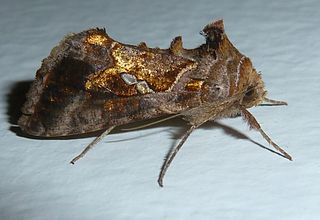
The tomato looper or golden twin-spot moth(Chrysodeixis chalcites) is a moth of the family Noctuidae, subfamily Plusiinae. It mainly lives in southern Europe, the Levant and tropical Africa, but can be seen migrating across much of Europe. In 2013, it was spotted in Canada. It is an important horticultural pest in New Zealand.

Agrotis innominata is a species of moth of the family Noctuidae. It is found in the coastal regions of New Zealand and is the only Agrotis species that is endemic to New Zealand.

Proteuxoa sanguinipuncta is a moth of the family Noctuidae. It is found in Queensland, New South Wales, Victoria, Tasmania, South Australia, and south Western Australia. It is also present in New Zealand where it was first recorded in 2007.

Diarsia is a genus of moths of the family Noctuidae.

Bityla sericea is a species of moth in the family Noctuidae. This species is endemic to New Zealand. It is classified as "At Risk, Naturally Uncommon" by the New Zealand Department of Conservation.

Zermizinga is a moth genus in the family Geometridae erected by Francis Walker in 1863. Species within this genus include Zermizinga sinuata, the lucerne looper or spider moth, which was described by Warren in 1897, as well as Zermizinga indocilisaria, which was described by Walker in 1863.

Diarsia dahlii, the barred chestnut, is a moth of the family Noctuidae. The species was first described by Jacob Hübner in 1813. It is found in Europe, through the Palearctic east to the Kamchatka Peninsula, northern China and Japan.

Protolampra sobrina, the cousin german, is a moth of the family Noctuidae. The species was first described by Philogène Auguste Joseph Duponchel in 1843. It is found in most of Europe, then east across the Palearctic to Siberia, Altai, Irkutsk, Kamchatka and Korea.

Diarsia brunnea, the purple clay, is a moth of the family Noctuidae. The species was first described by Michael Denis and Ignaz Schiffermüller in 1775. It is found in most of Europe, east to Transcaucasia, the Caucasus, central Asia, Siberia, the Kuriles, Amur, Ussuri, Sakhalin, Korea, Japan, and China, including China’s Tibet region.
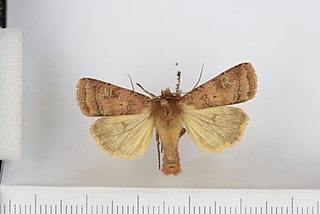
Diarsia florida, the fen square-spot, is a moth of the family Noctuidae. The species was first described by Schmidt in 1859. It is found from western Europe, Denmark, southern Norway and southern Sweden, east to Romania and Siberia. Subspecies perturbata is found in south-eastern Turkey.

Diarsia rosaria, the rosy dart, is a moth of the family Noctuidae. It is found from Ontario, Quebec, New Brunswick, Nova Scotia, Newfoundland and Labrador, British Columbia, Alberta, Saskatchewan and Yukon in Canada, south to northern California and eastern Oregon.

Australothis volatilis, also known as the fuzzweed moth, is a species of moth in the family Noctuidae. It is endemic to New Zealand. This species has been classified as critically endangered by the Department of Conservation.
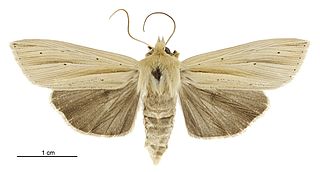
Ichneutica sulcana, the dark underwing wainscot, is a moth of the family Noctuidae. It is endemic to New Zealand and can be found throughout the North, South and Stewart Islands at a range of altitudes from the lowlands to the alpine zone. This species prefers to live in native grass, shrub and wetland habitats as well as in native forest. The larval host plants of this species are forest grasses and sedges and larvae have been reared on Microlaena avenacea and species within the genus Carex. The larva pupates in the soil. Adults are on the wing from December to May but have also been recorded in August and September in the northern parts of the North Island. They are attracted to sugar traps as well as to light. I. sulcana and I. supersulcana are very similar in appearance but can be distinguished as there are differences in the male abdomen and genitalia of the two species. Also these two species do not appear to share a range as I. supersulcana seems to prefer to live at higher altitudes than I. sulcana. I. sulcana might also be confused with I. semivittata but I. sulcana is a larger species with a much darker abdomen and hindwing, and has only 1 to 3 dots on the forewing postmedian line.

Ichneutica steropastis, or the flax notcher moth, is a species of moth in the family Noctuidae. It is endemic to New Zealand and can be found throughout the country from the Three Kings Islands to Stewart Island as well as in the Chatham Islands. The larvae of this species feed on a variety of native and introduced plants however the New Zealand flax is one of the more well known host plants for the larvae of this moth. The larvae are nocturnal, hiding away in the base of the plants and coming out to feed at night. They create a distinctive notch in the leaf when they feed. The adults of this species are on the wing from October to March. Although adult specimens of I. steropastis are relatively easy to recognise they might possibly be confused with I. inscripta, I. theobroma or with darker forms of I. arotis. However I. steropastis can be distinguished as it has a long dark basal forewing streak that these three species lack.
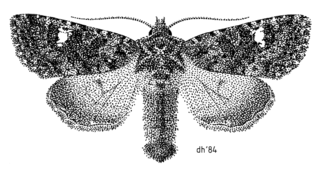
Meterana meyricci is a species of moth in the family Noctuidae. It was described and named by George Hampson in 1911 as Miselia meyricci. It is endemic to New Zealand and has been collected in and around Otago. The larvae of this species feed on Pimelea species, including Pimelea poppelwellii. Adults tend to found on the wing during the months of January to March.
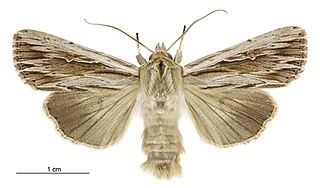
Persectania aversa, commonly known as the southern armyworm, is a moth of the family Noctuidae. It was first described in 1856 by Francis Walker. It is endemic to New Zealand and can be found throughout the country including the North, South, Stewart and Chatham Islands. This species inhabits open grasslands. Larvae feed on grass species including commercial crops such as oats and barley and as a result this species is regarded as an agricultural pest. Adults are nocturnal and are attracted to light. They are on the wing throughout the year.

Austramathes purpurea is a species of moth in the family Noctuidae. It is endemic to New Zealand and can be found throughout the North and South Islands but has yet to be recorded at Stewart Island. It inhabits native forest. This species might possibly be confused with A. pessota, however this latter species does not have the purple hue to the forewings. The larvae of A. purpurea feed primarily on māhoe but have been recorded as feeding on, and have been reared on, narrow-leaved māhoe. The larvae pupate in a silken cocoon on moss covered ground. Adults can be found on the wing during the months of March to January but mainly occur during New Zealand's late autumn, winter, and spring. Light trapping may not be the most efficient technique for collecting this species.
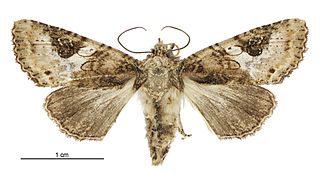
Meterana octans is a species of moth in the family Noctuidae. It was described by George Hudson in 1898 from specimens discovered by Alfred Philpott at Mount Linton, near Invercargill. It is endemic to New Zealand.

Ichneutica ceraunias is a moth of the family Noctuidae. It is endemic to New Zealand. This species is found from the central North Island to the bottom of the South Island. Hosts of the larvae are species of Chionochloa and Festuca. This colourful moth is variable in appearance and can be mistaken for Ichneutica dione. Adults are on the wing from October to February.



















